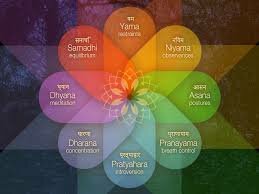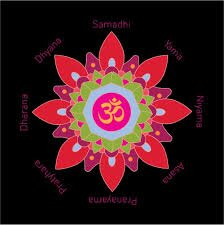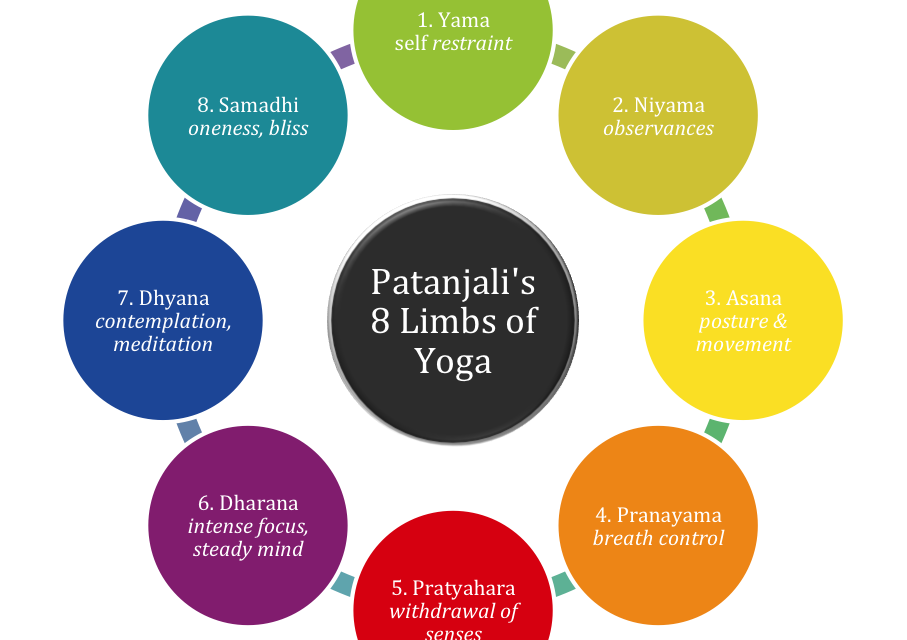Yoga is more than exercise. It is a system of tools for removing obstacles to living joyfully, understanding the self, living in the present and finding gratitude. This art of living was practiced and perfected in India more than 5,000 years ago. In approximately 200 AD, Patanjali recorded the foundation of yoga philosophy in The Yoga Sutras. This is an ancient text divided into 4 chapters containing 196 sutras or aphorisms that contains an eight-fold path to enlightenment. According to yoga philosophy these are the guidelines on how to lead a meaningful and purposeful life. In Sanskrit, this path is called ashtanga, which literally means eight limbs.
The practice of yoga is dedicated to creating a union of the body, mind, and spirit. It uses the body and breath to create awareness of self as an individual being, intimately connected to the unified whole of creation. The eight limbs serve as a prescription for self-discipline and ethical and moral conduct, to restore balance and equanimity, so as to live in peace, health, and harmony with the greater whole.
Patanjali’s eight-fold path contains the ancient wisdom of physical, spiritual, and intellectual practices that when practiced consistently help to bring the student more peace and joy in their lives by understanding the movements of their mind. Specifically this practice helps the student understand the source of their suffering and how to overcome limiting beliefs, attachments and the role of the ego self.

The eight limbs of yoga are:
- YAMA – Universal Morality
The first limb of yoga is concerned with personal integrity, ethical standards, and how we conduct ourselves in life. The five Yamas are universal practices closely related to the Golden Rule (do unto others as you would have them do unto you.
- Ahimsa: Nonviolence
- Satya: Truthfulness
- Asteya: Non-stealing
- Brahmacharya: Control of the senses
- Aparigraha: Non-covetousness
- NIYAMA – Personal Observances
The second limb is composed of rules prescribed for personal observance. The five Niyamas refer to attitudes we adopt toward ourselves in our code of living:
- Sauca: Purity
- Santosa: Contentment
- Tapas: Disciplined use of energy
- Svadhyaya: Self-study
- Isvarapranidhana: Celebration of the spiritual
- ASANA- Physical Postures
The practice of Asana (moving the body into yoga postures) benefits practitioners with improved health, strength, balance, and flexibility, and serves as a tool to calm the mind and contact the divine in our inner essence of being.
- PRANAYAMA – Breath Control
Breathing techniques are important in yoga and go hand-in-hand with Asana. Pranayama is measuring, controlling, and directing the breath, which leads to mastery of the connection between the breath and the mind and emotions.
- PRATYAHARA – Control of the Senses
“Pratyahara” means to draw back or retreat. It is a conscious effort to draw awareness inward, away from external stimuli, to make concentration possible.
- DHARANA – Concentration
“Dharana” means immovable concentration. The idea is to still the mind and hold the focus of attention in a single direction.
- DHYANA – Meditation or Contemplation
This is a state of keen awareness without focus, when the mind has been quieted and produces few or no thoughts.
- SAMADHI – Union with the Divine
Patanjali describes the eighth limb as a state of ecstasy in which the practitioner merges with the point of focus and transcends self altogether. The ultimate stage of yoga is enlightenment.
Story by: Sheryl Utal: Owner of Red Diamond Yoga Studio in LA











Recent Comments